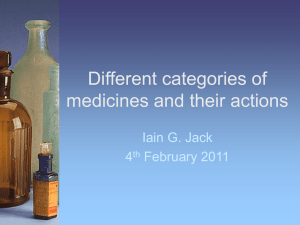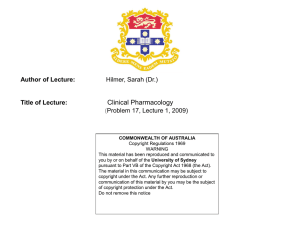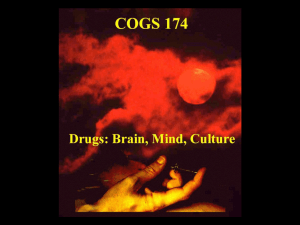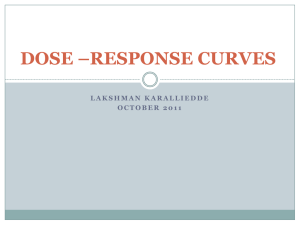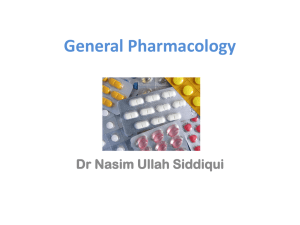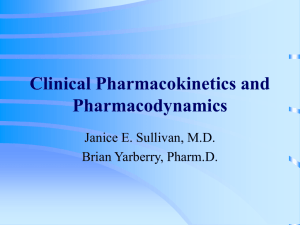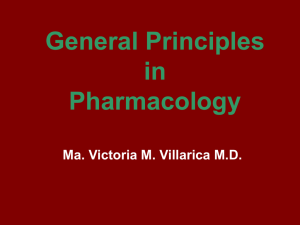Pharmacokinetiks and Pharmacodynamics
advertisement
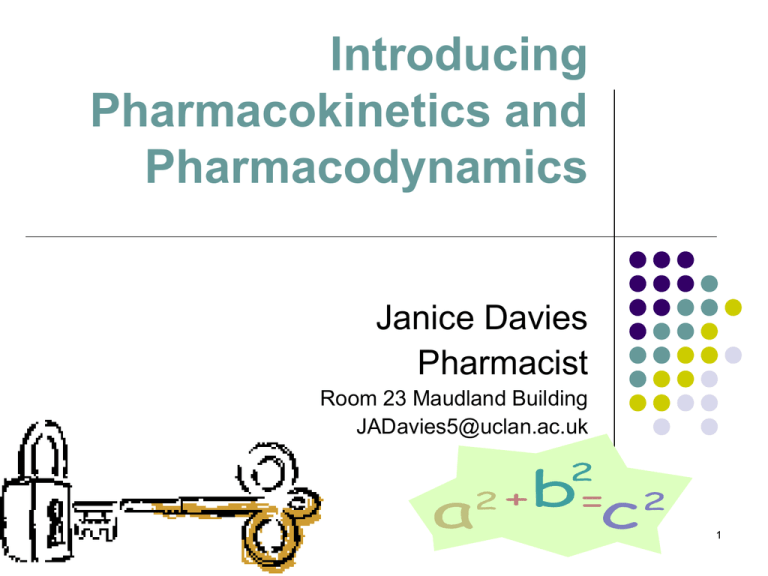
Introducing Pharmacokinetics and Pharmacodynamics Janice Davies Pharmacist Room 23 Maudland Building JADavies5@uclan.ac.uk 1 eLearn 2 DVD Any problems / questions? 3 Learning outcomes Define and discuss pharmacokinetic factors Discuss the factors that affect absorption, distribution, metabolism and excretion-how they affect drug therapy Define and discuss pharmacodynamic mechanisms of drug actions Apply pharmacokinetic and pharmacodynamic concepts to patient scenarios. 4 Definitions Pharmacokinetics is what the body does to the drugs, for almost all drugs the magnitude of pharmacological effect depends on its concentration at its site of action. Pharmacodynamics is what the drug does to the body, ideally including the molecular mechanism (s) by which the drug acts 5 PHARMACOLOGY PHARMACODYNAMICS (SPECIFIC TO DRUG OR DRUG CLASS) PHARMACOKINETICS (NON-SPECIFIC, GENERAL PROCESSES) 6 Arrange the phrases!!! Factors determining response of a patient to a drug 1) 2) 3) 4) 5) 6) 7) 8) 9) 10) 11) Drug interactions Duration of effect Unwanted effects Reduction in symptoms Modification of disease progression Accumulation on repeat dosage Absorption from the site of administration Elimination from the body Delivery to the site of action Effects at the site of action Interaction with cellular component 7 Pharmacokinetics:considering such terms as Route Absorption Distribution Hepatic Metabolism Metabolic products Protein Binding Renal Excretion Half-life Toxicity 8 Absorption Distribution Metabolism Excretion 9 Absorption Distribution Route Enteral oral Parenteral IV sublingual Topical transdermal Absorption inhalation Absorption Systemic circulation 10 Absorption Process of drug movement from the administration site to the systemic circulation. The amount and rate of absorption are determined by several factors: Physical nature of the dosage form Presence or absence of food in the stomach Composition of the GI contents Gastric or intestinal pH Mesenteric blood flow Concurrent administration with other drugs 11 Bioavailability “Bioavailability is the proportion of the administered dose that reaches the systemic circulation.” Dale and Haylet, Pharmacology Condensed. 2004 Refers to the amount and the rate of appearance of the drug in the blood after administration in its initial dose form Orally administered drug bioavailability is directly related to the individual solubility in body fluids. Poor solubility = low bioavailability 12 Effect of Food Bioavailability of some drugs is affected by the presence of food. E.g penicillin's, erythromycin, rifampicin, thyroxine Some drugs are taken before meals to allow time for drug to act before food is taken Gastric irritation can be caused by drugs taken on an empty stomach Effect of food on the absorption of drugs 13 First Pass Effect Drugs that are absorbed via the GIT are circulated to the liver first via the hepatic portal vein Liver then acts as a filter Only part of the drug is circulated systemically The combination of processes is termed the ‘First Pass’ effect 14 Absorption animation http://www.youtube.com/watch?v=xiuWdJYyI Ks 15 Absorption Distribution Metabolism Factors affecting Low albumin Problems with: Heart Circulation Diabetes Bound drugs are pharmacologically inactive because the drugprotein complex is unable to cross cell membranes. 16 Metabolism Drugs are metabolised in the liver, lungs, kidneys, blood and intestines. In order for drugs to pass across the lipid cell membrane they must be lipophilic The higher the solubility in lipids compared to water, the more rapid the tissue entry Metabolic rate determines the duration of the action of the drugs Which BNF appendix relates to patients’ ability to metabolise? 17 Excretion Drugs are primarily excreted by the kidneys In order for drugs to be excreted they need to become hydrophilic Excretion of drugs can be affected by the urinary pH How the drug is excreted can influence prescribing decisions Which BNF appendix relates to patients’ ability to excrete? 18 Half Life of Drugs Drug excretion is commonly expressed in terms of half life (t1/2) This is the time required for the concentration of the drug in the plasma to decrease by one-half of it’s initial value Drug half life is variable and can be long or short Subsequent doses are given to raise the concentration levels to a peak In theory, the optimal dosage interval between drug administration is equal to the half-life of the drug 19 Example Drug 100mgs with a 6 hour half life 1st dose 100 mgs 2nd dose 100mgs + 50 mgs still present = 150mgs 3rd dose 100mgs + 75 mgs still present = 175mgs 4th dose 100mgs + 88mgs still present = 188mgs 5th dose 100mgs + 94mg still present = 194mgs 6th dose 100mgs + 97mg still present = 197mg As can be seen, accumulation becomes less at each dose- “steady state” is achieved after 3 to 5 half lives. 20 Loading Doses Are used when the medical condition demands high concentrations very quickly This is achieved by an initial dose that is twice the maintenance dose 21 Some exam style MCQs: 22 Which ONE of the following affects absorption? Drug formulation Time of administration Mode of action of the drug 23 A patient with renal impairment, taking a renally excreted drug, will require which ONE of the following? Dose reduction Dose increase Same dose 24 Which ONE of the following describes bioavailabilty? The proportion of drug reaching the circulation The extent of first pass metabolism The quantity of drug absorbed in the GI tract 25 Tea break… http://www.youtube.com/watch?v=tnnoPedW O7M …best to leave now if easily offended! 26 Pharmacodynamics “is the detailed study of the mode of action of drugs in the body” or how drugs exert their effect at a cellular level Receptors Ion channels Enzymes Carrier molecules Chemotherapy 27 Considering Receptors-agonist, partial agonist and antagonist Ion channels-gating of intracellular ions Enzymes-drugs act to inhibit or potentiate Carrier molecules-allow molecules not lipid soluble to cross cell membrane Chemotherapeutic agents Drug tolerance/dependence Effects of pathological state and biological variability 28 Receptors Receptors are a target molecule that a drug molecule has to combine with to produce a specific effect Receptors must be compatible –like 2 pieces of a jigsaw e.g. neurotransmission Main types of action at receptor: Receptor agonists Receptor antagonists 29 Types of receptors G-protein-couple receptors, seconds e.g. Muscarinic ACh receptors, adrenoceptors, histamine receptors http://www.ouhscphysio.org/humanphys/animat ions/g-protein_coupled_receptors.gif Kinase linked receptors, hours e.g. Insulin, Growth factor Nuclear intracellullar receptors, hours e.g. steroid, thyroid hormone 30 Ion Channels Drugs act to affect cellular gating mechanism in cell wall Ligand-gated ion channels, milliseconds e.g GABA benzodiazepines, Nicotinic ACh http://www.ouhscphysio.org/humanphys/animations /ligand-gated.swf Carrier molecules Drugs act on carrier transporters which allow molecules, not lipid soluble to cross cell membrane http://www.ouhscphysio.org/humanphys/animations /facilitated_diffusion.swf 31 Enzyme inhibitors An enzyme is a protein that can promote or accelerate a biochemical reaction with a substrate When the enzyme mistakes the drug for a substrate, a drug-enzyme interaction occurs This interaction could increase or decrease the rate of the biochemical reaction 32 33 Chemotherapeutic agents Cytotoxic drugs act by interfering with cell growth and division at different stages of the cycle Anti-infective drugs 34 Bacterial Cell Cell wall Cell membrane DNA Metabolism of bacterial cell Amino acids Class 3 reactions Class 2 reactions Class 1 reactions Glucose Precursor molecules Nucleotides Proteins RNA DNA 35 Physiological Variability Liver disease Chronic alcoholism Renal disease Allergy 36 Exam Style MCQs a) b) c) A receptor antagonist: binds to a receptor and activates it binds to a receptor without causing activation blocks an enzyme 37 a) b) c) The pharmacodynamics of salbutamol can be explained by its: activity on enzymes activity on ion channels activity on receptors 38 Warfarin has a: a) b) c) Narrow Therapeutic Index Wide therapeutic range Neither are important 39 Write brief notes on any TWO of the following modes of drug action: Receptor agonists Receptor antagonists Action at enzymes Ion channels Carrier molecules Chemotherapy 40 Short answer questions: What is a narrow therapeutic index? What is bioavailability? What is half life? What is a loading dose? What is pharmacodynamics? 41 Further reading Downie, George (2008) Pharmacology and medicine management for nurses George Downie, Jean Macke 4th Edition , Edinburgh. Churchill Livingstone OR Trounce, J, Greenstein, B, Gould, D. Trounces Clinical Pharmacology For Nurses. 18th Edition Churchill Livingstone Edinburgh. British National Formulary www.bnf.org Rang Dale Ritter and Moore (2003) Pharmacology Churchill Livingstone Bath Press 5th edition www.emc.medicines.org.uk 42



